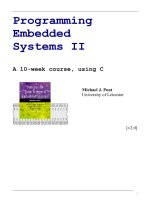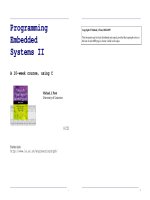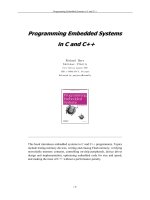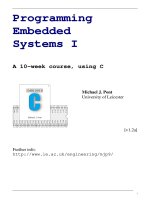Program C Ansi Programming Embedded Systems in C and C++ phần 9 pptx
Bạn đang xem bản rút gọn của tài liệu. Xem và tải ngay bản đầy đủ của tài liệu tại đây (27.8 KB, 11 trang )
Part of a software package that is processor- or platform-dependent. Typically, sample
source code for the board support package is provided by the package developer. The sample
code must be modified as necessary, compiled, and linked with the rest of the software
package.
breakpoint
A location in a program at which execution is to be stopped and control of the processor
switched to the debugger. Mechanisms for creating and removing breakpoints are provided
by most debugging tools.
< BACK CONTINUE >
C
CISC
Complex Instruction Set Computer. Describes the architecture of a processor family. CISC processors generally
feature variable-length instructions and multiple addressing formats, and contain only a small number of general-
purpose registers. Intel's 80x86 family is the quintessential example of CISC. Contrast with RISC.
CPU
Central Processing Unit. The part of a processor that executes instructions.
compiler
A software development tool that translates high-level language programs into the machine-language instructions
that a particular processor can understand and execute.
context
The current state of the registers and flags of the processor.
context switch
The process of switching from one task to another in a multitasking operating system. A context switch involves
saving the context of the running task and restoring the previously saved context of the other. The piece of code that
does this is necessarily processor-specific.
counting semaphore
A type of semaphore that is used to track multiple resources of the same type. An attempt to take a counting
semaphore is blocked only if all of the available resources are in use. Contrast with binary semaphore.
critical section
A block of code that must be executed in sequence and without interruption to guarantee correct operation of the
software. See also race condition.
cross-compiler
A compiler that runs on a different platform than the one for which it produces object code. A cross-compiler runs
on a host computer and produces object code for the target.
D
DMA
Direct Memory Access. A technique for transferring data directly between two peripherals
(usually memory and an I/O device) with only minimal intervention by the processor. DMA
transfers are managed by a third peripheral called a DMA controller.
DRAM
Dynamic Random-Access Memory. A type of RAM that maintains its contents only as long
as the data stored in the device is refreshed at regular intervals. The refresh cycles are usually
performed by a peripheral called a DRAM controller.
DSP
See digital signal processor.
data bus
A set of electrical lines connected to the processor and all of the peripherals with which it
communicates. When the processor wants to read (or write) the contents of a memory
location or register within a particular peripheral, it sets the address bus pins appropriately
and receives (or transmits) the contents on the data bus.
deadline
The time by which a particular set of computations must be completed. See also real-time
system.
deadlock
An unwanted software situation in which an entire set of tasks is blocked, waiting for an
event that only a task within the same set can cause. If a deadlock occurs, the only solution is
to reset the system. However, it is usually possible to prevent deadlocks altogether by
following certain software design practices.
debug monitor
A piece of embedded software that has been designed specifically for use as a debugging
tool. It usually resides in ROM and communicates with a debugger via a serial port or
network connection. The debug monitor provides a set of primitive commands to view and
modify memory locations and registers, create and remove breakpoints, and execute your
program. The debugger combines these primitives to fulfill higher-level requests like
program download and single-step.
debugger
A software development tool used to test and debug embedded software. The debugger runs
on a host computer and connects to the target through a serial port or network connection.
Using a debugger, you can download software to the target for immediate execution. You can
also set breakpoints and examine the contents of specific memory locations and registers.
device driver
A software module that hides the details of a particular peripheral and provides a high-level
programming interface to it.
device programmer
A tool for programming nonvolatile memories and other electrically programmable devices.
Typically, the programmable device is inserted into a socket on the device programmer and
the contents of a memory buffer are then transferred into it.
digital signal processor
A device that is similar to a microprocessor, except that the internal CPU has been optimized
for use in applications involving discrete-time signal processing. In addition to standard
microprocessor instructions, DSPs usually support a set of complex instructions to perform
common signal-processing computations quickly. Common DSP families are TI's 320Cxx
and Motorola's 5600x series.
E
EEPROM
Electrically Erasable, Programmable Read-Only Memory. (Pronounced "double-E PROM.")
A type of PROM that can be erased electronically.
EPROM
Erasable, Programmable Read-Only Memory. A type of PROM that can be erased by
exposing it to ultraviolet light. Once erased, an EPROM can be reprogrammed with the help
of a device programmer.
embedded system
A combination of computer hardware and software, and perhaps additional mechanical or
other parts, designed to perform a specific function. Contrast with general-purpose computer.
emulator
Short for In-Circuit Emulator (ICE). A debugging tool that takes the place of-emulates-the
processor on your target board. Emulators frequently incorporate a special "bond-out"
version of the target processor that allows you to observe and record its internal state as your
program is executing.
executable
A file containing object code that is ready for execution on the target. All that remains is to
place the object code into a ROM or download it via a debugging tool.
firmware
Embedded software that is stored as object code within a ROM. This name is most common
among the programmers of digital signal processors.
Flash memory
A RAM-ROM hybrid that can be erased and rewritten under software control. Such devices
are divided into blocks, called sectors, that are individually erasable. Flash memory is
common in systems that require nonvolatile data storage at very low cost. In some cases, a
large Flash memory is even used instead of a disk-drive.
general-purpose computer
A combination of computer hardware and software that serves as a general-purpose
computing platform. For example, a personal computer. Contrast with embedded system.
H
HLL
See high-level language.
heap
An area of memory that is used for dynamic memory allocation. Calls to malloc and free and
the C++ operators new and delete result in runtime manipulation of the heap.
high-level language
A language, such as C or C++, that is processor-independent. When you program in a high-
level language, it is possible to concentrate on algorithms and applications without worrying
about the details of a particular processor.
host
A general-purpose computer that communicates with the target via a serial port or network
connection. This term is usually used to distinguish the computer on which the debugger is
running from the embedded system that is being developed.
I
ICE
In-Circuit Emulator. See emulator.
I/O
Input/Output. The interface between a processor and the world around it. The simplest
examples are switches (inputs) and LEDs (outputs).
I/O device
A piece of hardware that interfaces between the processor and the outside world. Common
examples are switches and LEDs, serial ports, and network controllers.
I/O map
A table or diagram containing the name and address range of each peripheral addressable by
the processor within the I/O space. I/O maps are a helpful aid in getting to know the
hardware.
I/O space
A special memory region provided by some processors and generally reserved for the
attachment of I/O devices. Memory locations and registers within an I/O space can be
accessed only via special instructions. For example, processors in the 80x86 family have
special I/O space instructions called in and out. Contrast with memory space.
< BACK CONTINUE >
L
linker
A software development tool that accepts one or more object files as input and outputs a relocatable program. The
linker is thus run after all of the source files have been compiled or assembled.
locator
A software development tool that assigns physical addresses to the relocatable program produced by the linker. This
is the last step in the preparation of software for execution by an embedded system, and the resulting file is called an
executable. In some cases, the locator's function is hidden within the linker.
logic analyzer
A hardware debugging tool that can be used to capture the logic levels (0 or 1) of dozens, or even hundreds, of
electrical signals in real time. Logic analyzers can be quite helpful for debugging hardware problems and complex
processor-peripheral interactions.
M
memory map
A table or diagram containing the name and address range of each peripheral addressable by
the processor within the memory space. Memory maps are a helpful aid in getting to know
the hardware.
memory-mapped I/O
Common hardware design methodology in which I/O devices are placed into the memory
space rather than the I/O space. From the processor's point of view, memory-mapped I/O
devices look very much like memory devices.
memory space
A processor's standard address space. Contrast with I/O space.
microcontroller
A microcontroller is very similar to a microprocessor. The main difference is that a
microcontroller is designed specifically for use in embedded systems. Microcontrollers
typically include a CPU, memory (a small amount of RAM, ROM, or both), and other
peripherals on the same chip. Common examples are the 8051, Intel's 80196, and Motorola's
68HCxx series.
microprocessor
A piece of silicon containing a general-purpose CPU. The most common examples are Intel's
80x86 and Motorola's 680x0 families.
monitor
In the context of this book, a debug monitor. However, there is a second meaning for this
word that is associated with intertask communication. In that context, a monitor is a
language-level synchronization feature.
multiprocessing
The use of more than one processor in a single computer system. So-called "multiprocessor
systems" usually have a common memory space through which the processors can
communicate and share data. In addition, some multiprocessor systems support parallel
processing.
multitasking
The execution of multiple software routines in pseudoparallel. Each routine represents a
separate "thread of execution" and is referred to as a task. The operating system is
responsible for simulating parallelism by parceling out the processor's time.
mutex
A data structure for mutual exclusion, also known as a binary semaphore. A mutex is
basically a multitasking -aware binary flag that can be used to protect critical sections from
interruption.
mutual exclusion
A guarantee of exclusive access to a shared resource. In embedded systems, the shared
resource is typically a block of memory, a global variable, or a set of registers. Mutual
exclusion can be achieved with the use of a semaphore or mutex.
< BACK CONTINUE >
N
NVRAM
Nonvolatile Random-Access Memory. A type of RAM that retains its data even when the system is powered down.
NVRAM frequently consists of an SRAM and a long-life battery.
OTP
See one-time programmable.
object code
A set of processor-readable opcodes and data. The output of compilers, assemblers, linkers,
and locators are files containing object code.
object file
A file containing object code. The output of a compiler or assembler.
one-time programmable
Any programmable device, like a PROM, that can be programmed just once by the end user.
However, this term is used almost exclusively to refer to microcontrollers that have on-chip
PROM.
opcode
A sequence of bits that is recognized by the processor as one of the instructions in its
instruction set.
operating system
A piece of software that makes multitasking possible. An operating system typically consists
of a set of function calls, or software interrupts, and a periodic clock tick. The operating
system is responsible for deciding which task should be using the processor at a given time
and for controlling access to shared resources.
oscilloscope
A hardware debugging tool that allows you to view the voltage on one or more electrical
lines. For example, you might use an oscilloscope to determine if a particular interrupt is
currently asserted.
P
PROM
Programmable Read-Only Memory. A type of ROM that can be written (programmed) with a
device programmer. These memory devices can be programmed only once, so they are
sometimes referred to as write-once or one-time programmable devices.
parallel processing
The ability to apply two or more processors to a single computation.
peripheral
A piece of hardware other than the processor, usually memory or an I/O device. The
peripheral can reside within the same chip as the processor, in which case it is called an
internal peripheral.
physical address
The actual address that is placed on the address bus when accessing a memory location or
register.
preemptive
A scheduler is said to be preemptive if it allows the running task to be suspended when a
higher-priority task becomes ready. Non-preemptive schedulers are easier to implement but
less appropriate for embedded systems.
priority
The relative importance of one task compared to another.
priority inversion
An unwanted software situation in which a high-priority task is delayed while waiting for
access to a shared resource that is not even being used at the time. For all practical purposes,
the priority of this task has been lowered during the delay period.
process
A word that is often confused with task or thread. The crucial distinction is that all of the
tasks in a system share a common memory space. Processes, on the other hand, always have
their own private memory space. Processes are common in multi-user systems but are rarely,
if ever, found in embedded systems.
processor
A generic term that does not distinguish between microprocessor, microcontroller, and
digital signal processor. I have purposefully used this term throughout the book because the
actual processor type has very little impact on the type of embedded software development
described here.
processor family
A set of related processors, usually successive generations from the same manufacturer. For
example, Intel's 80x86 family began with the 8086 and now includes the 80186, 286, 386,
486, Pentium, and many others. The later models in a family are typically backwards-
compatible with the ones that came before.
processor-independent









